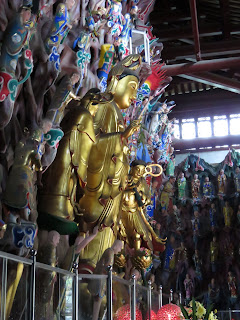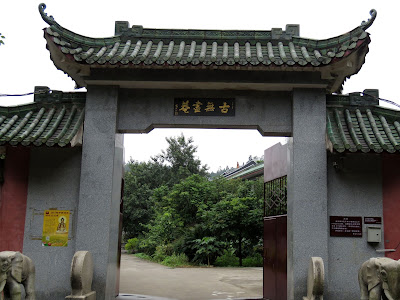
The reputable Buddhist Temple Nanhua-si (南华禅寺), locating at Caoxi Brook within Qujiang District about 24km away from Shaoguang County in Canton, was the site where the 6th Buddhist Patriarch Rev. Huineng (638-713) dwelt for 37 years expounding the Buddhist teachings and established the southern sect of Chinese Zen Buddhism. The Monastery has a history of nearly 1500 years since it was first built in year 502, during the reign of Emperor Liangwu-di. Though facing few times of deserted and declined during wars within the subsequent dynasties, it was restored, reconstructed and renovated. When the temple was restored in year 968 after attack of fire in Song Dynasty (960-1179), the name was changed to Nanhua-chan-si (南华禅寺). Most of the existing structures in the temple complex today was renovated in year 1934 by Master Xuyun (虚云和尚)



The teachings of Master Huineng was gradually developed into five lineages by his 43 disciples who had inherited his Dharma and had spread over to Korea, Japan, South East Asia and Western countries. Many benefited from his teaching and awoke to their spiritual way. Nanhua-si Temple thus became an ancestry Bodhimanda of Zen Buddhism in China, attracting hundreds and hundreds of Zen followers and Buddhist devotee from all places, to come and pay homage.



Temple Nanhua-si occupies a total land area of 105 acres. The complex comprises of a series of magnificent Buddhist structures rhythmically arrayed along a central axis with its main Grand Shrine Hall at the center, as illustrated in the drawing. Caoxi Gate, Baolin Gate, Heavenly Kings Deva Hall, Sutra Depository, Patriarch Hall and Lingzhao Pagoda are few of its essential structures.



The original structures of Nanhua-si had been damaged several times. New buildings and structures were restored and re-constructed in accordance to the distinctive aspect of Chinese ancient architectural style with symmetrical arrangement.





Wuxiang-Ting (五香亭) which literally means Pavilion of five fragrances, is the most elegant structure at site. It is octagonal in shape with 8 round pillars, 5 flip-up eave edges, a pointed roof top and a round ceiling beautifully ornamented with flying deva. It stands over a limestone built oval shaped liberation pond.


Wuxiang-Ting is linked up with Caoxi entrance pass gate and Baolin Pass Gate by a central axis cutting through the Liberation Pond.



Baolin Gate Pass is the second entrance into temple complex. It was built in year 1534 and restored in 1912. Lying behind it, is the magnificent building of Heavenly Kings Deva Hall.



Baolin Daochang (宝林道场)which was the original name of Nanhua-si, was painted in gold and hanged up at the door lintel of second Gate Pass. The verses from pair of couplet reads as "东粤第一宝刹,南宗不二法门" meaning "This is number one Buddhist Monastery in East Canton, The only access of getting into Southern Sect Zen Buddhism".



The site of Heavenly Kings Deva Hall.



Gilded huge Alms Bowl


Old Stone lanterns



The clay sculptures of dragon, storks and lotus flowers at the steps in front of Heavenly Kings Deva Hall are vivid.



Heavenly Kings Deva Hall is enshrined with a huge image of Maitreya Bodhisattva with four mighty statues of heavenly kings Deva on its both sides.



The splendor Heavenly Kings Deva Hall was originally an Arhat Hall. It was first constructed in 1474 during Ming Dynasty and restored in Qing Dynasty (1644-1911).


Building of Depository of Buddhist Texts where many precious cultural relics are kept, including an ancient edition of Mahayana Canon, is not opened for public.


The large metal cauldron measured as 209cm x 160cm was cast in year 1338. It was said that the cauldron was able to boil rice for thousand of monks but the edge where some inscription was found had been rusted.



Temple Nanhua-si holds many interesting national treasures, which we believed, are not opened to public. The most precious items among all include a Decree from Tang Dynasty (618-905) issued by the Empress Wu-Zhetian in year 696 and a rare cassock with elaborate embroidery of over a thousand seated Buddha images, sewn in golden thread. It was a gift bestowed to Master Huineng by Emperor Zhongzong in early 7th century. The 360 Buddhist heritage relic of wood carved Arhat Images sculpted during the reign of Song-Renzong within years 1043 to 1048 are also of high value. Each Arhat figure has a distinctive posture with different expression and was mostly carved out from a whole piece of cypress wood log, measured about 50-58cm in height with 24-28cm in width. The great job was organized and contributed by Devotee Yang-renxi (杨仁禧) with supports from all Buddhist enthusiasts in all levels, nearly 1000 years ago. They are the only one of the kind in China that were preserved from that period.



The 3-storey Bell tower was built in 1306 during Yuan Dynasty (1271-1368). Its 9 ft tall with 6 ft in diameter brass bell was cast during Song Dynasty (1127-1279). Bell Tower and Drum Tower are facing each other by the side of Main Shrine Hall.



The Grand Hall Daxiong Baodian (大雄宝殿) is an important place to hold ritual in all temples. In Nanhua-si, it is the largest and uppermost ancient building with roof entirely covered with glazed tiles. The building was first constructed in year 1306 and renovated in Ming and Qing Dynasty within 14th to early 20th century.


The huge brass incense cauldrons of Grand Shrine Hall.





Enshrined in the Grand Main Shrine are three 8 meters tall sublime images of Sakyamuni Buddha, Bhaisajya-guru Medicine Buddha and Amitabha Buddha, all gilded in gold.


The life-like group fine clay sculptures of 500 Buddhist Arhats are impressive. They are standing at all sides of walls in Grand Shrine with sculpted wavy sea as the background. Each figure has its characteristic feature with vivid expression.



We appreciated so much for the guard who exceptionally allowed us to take picture, which actually are prohibited inside the hall.



The 4 meters high gilded image is Avalokitesvara (Guangyin) Bodhisattva.



Details of Grand Hall repair work was clearly stated on the board.



The Maha Bodhi tree.



Standing behind the 6th Patriarch Hall is the splendor Lingzhao Pagoda which is the oldest structure in the complex of Nanhua-si. The original wood structure built during Tang Dynasty (618-907) was destroyed by fire. The present brick and stone structure was restored in Song Dynasty (960-1279). Pagoda was built initially to enshrine the mummified body relic of Rev. Huineng.



Bowing to Baozhuang Buddha (宝幢佛)enshrined in the little shrine hall of Lingzhao Pagoda to bring forth the Bodhi resolve.



Chinese always say seven make a Pagoda but Lingzhao has only five levels as in ancient time, earth and heaven are considered as one level each.


The board stated that there are incredible benefits for one who sincerely pay homage to a Buddhist Pagoda or mindfully walk around it. The deed would help you to reduce bad Karma, waive hindrances and gain merits and blessings.


There are many stone stele and plague within the inner yard. The most outstanding is the memorial plague of devotee Chan-Axin who generously donate a piece of land to temple, making the premises of Nanhua-si to today's scale. Sadhu



Inscription of many old stele had been faded.



The 6th Patriarch Hall enshrined mummified body relic of three great masters. Rev. Huineng (638-713) was the founder of Chinese Southern Sect Zen Buddhism and had been expounding Buddhist Dharma for 37 years in Nanhua Temple. After he passed away at the age of 76 in year 713, his body was mummified, gilded and enshrined in Nanhua-si. It had already been in the temple for more than 1300 years. The teachings of 6th Patriarch Huineng were compiled by his disciples in the 6th Patriarch's Dharma Jewel Platform Sutra.


Rev. Dantian (丹田大师 1535-1614) was a great Zen Master in Ming Dynasty. He had been delving deep into Diamond Sutra for his whole life and never missed a single day to recite it. His mummified body relic had been kept in the temple for more than 400 years.


Another mummified body relic belongs to Rev. Hanshan (憨山大师 1546-1623) who was one of the four great zen masters in Ming Dynasty (1368-1628). He spent most of his life time, traveling, studying and practicing Zen Buddhism. In 14th century, Nanhua-si suffered severe damages in several wars and declined. The temple was abandoned when Master arrived in year 1600. He repaired and restored the temple extensively, in the meantime, setting system to train the monks with proper Buddhist rules and regulations. He put much effort for the resurgence of the temple for 23 years. His body was mummified and gilded after he passed away 390 years ago.



Many devotees make flower offerings to the three great masters enshrined in 6th Patriarch Hall. Buddhists believe that offering flowers to Buddha, Bodhisattva or any Sages, one will be borne with handsome look and with great fortune and blessings in the next life.



Paying respect and homage to the Stupa of Greatest enlightened Master Rev. Xuyun (1840-1959) who revitalized the Zen School in China and re-transmitted all five of the authentic Zen lineages, founded by Master Huineng more than 1300 years ago.


Master Xuyun is a Bodhisattva and I am blessed to have come and pay homage to his Stupa. It locates amidst in a wood of greenery, just short working distance from his memorial hall in Nanhua Temple.



Master. Xuyun (1840-1959) was the greatest and most influential Dharma Teachers of Zen Buddhism in China during 19th to 20th century. He was borne as Xiao-Guyan (萧古严) on 26th August 1840 in Fujian when his father was transferred for duty from his homeland Hunan to that state. At the age of 19, Master went against his father's will, left home, shaved and ordained as a monk in Fuzhou's Gushan Temple in the following year. In order to avoid being escorted back home, he concealed himself in a cave behind the temple, living in austere solitude for three years. His father passed away when he was 25. Master met and learned from many great masters while traveling and visiting temples from one place to another. At the age of 36, he took advice from a monk, and spent 7 years paying pilgrimage to Putuoshan, the Bodhimanda of Avalokitesvara Bodhisattva, and from Putoushan, he bowed from all the way through in full prostration every 3 steps to Wutaishan, the Bodhimanda of Manjusri, to repay the love and kindness of his parents. During the 4 years' journey to Wutaishan, he was twice saved by the incarnation of B.Manjusri when in danger. Master Xuyun was not only extensively traveling within monasteries and holy places around China continent, his foot prints were also found in Tibet, India, Sri Lanka, Myanmar and many countries in south East Asia. At the time when he returned and began to repair and restore Nanhua Temple, he had reached an age of 96.



Master Xuyun had been Abbot for 15 monasteries and had restored and rebuilt 6 main ancestry temples including Nanhua-si. For the 100 years of his Sangha life, he worked very hard for the benefits of Buddhism and restlessly gave taught to Dharma, precepts and Buddhist texts. Master was the only one in China or may be in the whole world who inherited the Dharma of five lineages derived from Chinese Zen Buddhism, and who had millions of disciples and devotees following his teachings.


Deep inside the wood at the back of Nanhua Monastery, stand The tower of sea assembly which we were not allowed to enter as it was under renovation.
Nunnery of Endless Sufferings Kuwujing-an (苦无尽庵)was another group structures in the premises of Nanhua-si.


The Hall of Kuwujing Nunnery and its dormitory.



Artifacts in nunnery




Nanhua-si was built against mountain range by the side of Caoxi Creek.



The scenic mountain view in front of temple complex.



Rows of shops selling Buddhism related items, incense and candles are lined up along the side street outside Nanhua Temple.







No comments:
Post a Comment